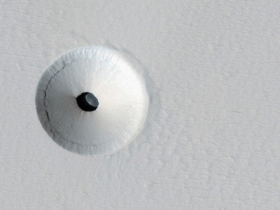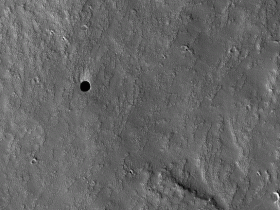

Image Credit: NASA, JPL, U. Arizona
Jul 25, 2012
With no explanation for the surrounding crater, mainstream astronomy imagines this to be a hole leading to an underground cavern. The challenges to this view should be obvious.
The HiRISE camera on the Mars Reconnaissance Orbiter is delivering to us some delicious, high resolution pictures of Mar’s surface features. There are more than enough anomalous features to instigate a re-evaluation of current planetology theory, but the lack of such is a testament to the power of a paradigm and the momentum of prevailing opinion.
This distinctive crater on the surface of Mars is about 35 meters in diameter and the center hole is unusually deep, about 20 meters. The crater and the surrounding area are devoid of the earmarks of an impact, and astronomers must be at a loss to even speculate about the cause of the crater.
They imagine the hole to be an underground cavern or leading to a cavern, but this is pure speculation with no evidence except, “What else could it be?”
Another circular hole the size of a football field and having a slight rim, with no crater around it, can be seen on the side of Arsia Mons. You can hardly figure that these very regular or smooth sided holes can be caused by collapse from a cavern below.
On the other hand, the EU view has long been that circular craters are overwhelmingly the product of interplanetary, rotating vertical electric discharges that machine away the material via EDM. These do so by virtue of “sticking” to a spot and rotating about the point. Besides the significant similarities of these circular craters, the differences can easily be explained by the possible variables in an electrical discharge, different polarity, charge differential, current flows, material conductivity, duration, intensity, charge capacity from the surrounding area, etc.
Sometimes these discharges, while accelerating material away, have left ridges piled around the crater along with significant scattered material apparent in the surrounding area. Sometimes they have left an undisturbed central peak, or a flat floor, or in this case a floor sloping down to the definitive circular hole in the center. The EU speculation for this Martian surface feature would be that this discharge was particularly intense at the end, drilled a smaller circular hole and lofted most of the machined material into space, leaving very little remaining debris.
Michael Armstrong












